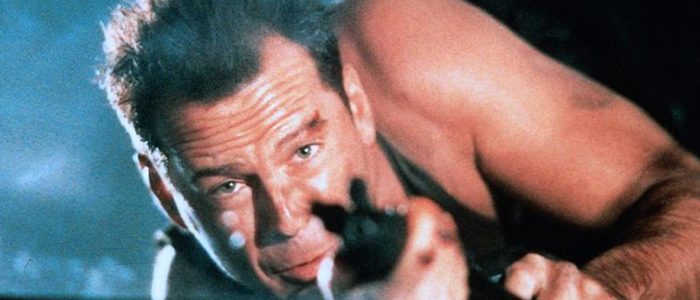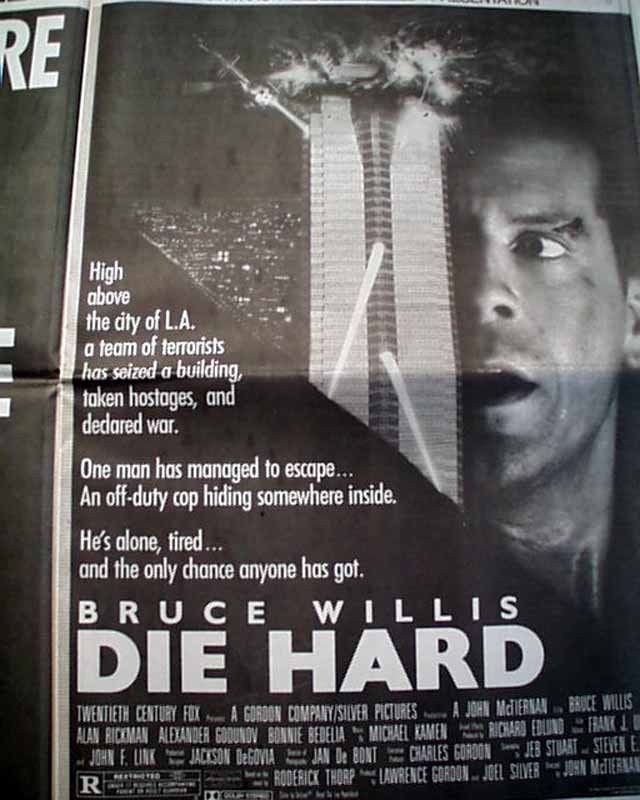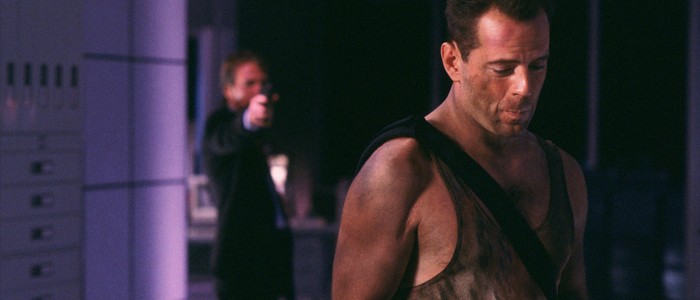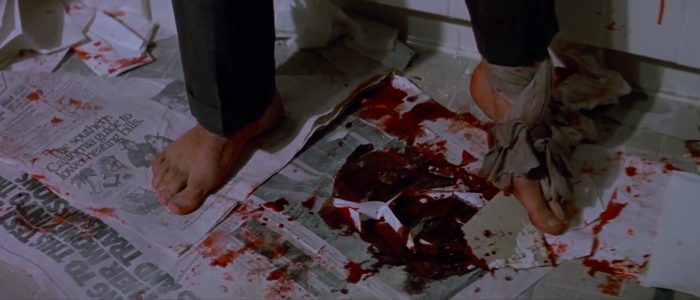
(This week marks the 30th anniversary of Die Hard, arguably the greatest action movie of all time. To celebrate, /Film is exploring the film from every angle with a series of articles. Today: we spoke with ten modern filmmakers about why the movie still holds up, how it influenced their work, and more.)
The first shot in Die Hard is a plane landing on a runway. But the second shot does something relatively atypical for the testosterone-fueled action movies of the 1980s: it established a weakness in its protagonist. New York cop John McClane (Bruce Willis) is afraid of flying, and the first thing we see of him is his hand tightly gripping his armrest. His seat neighbor gives him an odd remedy for stress relief, and when McClane eventually gives it a try during a Christmas party at L.A.’s Nakatomi Plaza, a hostile takeover leaves him barefoot at the worst possible moment.
But that weakness gives the character some much-needed humanity, a far cry from the muscle-bound lugs embodied by actors like Schwarzenegger and Stallone at the time. That humanity and relatability is a huge part of the reason the film remains a stone cold classic three decades after its release. In the latest entry in our series of articles looking back on Die Hard, /Film spoke with a handful of modern Hollywood directors and writers about the impact the film had on them, how it influenced their work, why the movie has stood the test of time, and more.
Darren Aronofsky (Writer/Director – Requiem for a Dream, The Wrestler): I love that it starts off with “Christmas in Hollis” by Run-DMC. I can still remember that moment when I was in the theater in Brooklyn and it came blasting through the sound system. The crowd went nuts.

Colin Trevorrow (Co-Writer/Director – Jurassic World, upcoming Jurassic World 3): I was eleven when Die Hard came out. I remember the look on Bruce Willis’ face in the newspaper ad. The guy was clearly in a serious situation. I had to see the movie. The San Francisco Chronicle has a different system for reviewing films—instead of stars it’s a little cartoon man in various levels of enjoyment. If he doesn’t like the movie, the chair is empty. Next level up he’s asleep. Then he’s watching attentively, then clapping. But the highest level, the one I will reach for my whole career, is the little man jumping on his chair, just going nuts. I remember Die Hard had the highest level of little man enjoyment. But there was no chance I was getting into the movie theater. So I waited. Watched from afar. And in the summer of ’89, my neighbor Brandon rented it with his dad. I nonchalantly asked if I could have dinner at Brandon’s that night.
Dan Trachtenberg (Director – 10 Cloverfield Lane): It was playing in a video store and I was sneaking glances of it while being ushered away with my friends when I was in elementary school and dying to see it for real. I fell in love with it, of course, when I finally saw it. But even at a young age, Die Hard really – I was like, ‘Oh my God, he’s a regular guy! And his feet hurt!’ I was able to receive all of what was really, really special about it. I liked his balding hair and how he looked like a tough dude in the tank top, and I remember saying, ‘I wish I looked cool like that. I hate that I’m so skinny.’ I wanted to look more like a dad because I thought he was so cool.
Paul Scheer (Writer – NTSF:SD:SUV, upcoming Galaxy Quest): As a kid, seeing Die Hard was like, ‘Whoa!’ You could be funny and you were charming, but you were also a guy that looks like – for lack of a better term – a normal person. You’re not all buffed up. You’re not even ‘Paul Rudd in Ant-Man’ buffed up. It really felt like this novel thing.
Joe Carnahan (Writer/Director – The A-Team, The Grey): I remember at the time, it was, ‘Hey, the guy in Moonlighting is in an action movie!’ People were laughing about it. I don’t think a lot of people were taking it seriously. But I remember going opening weekend. I think I went on a Saturday night and the theater was full, and I remember thinking, ‘Wow, that movie kicked ass! Holy shit, the guy from Moonlighting! That was a legit action movie! That was great!’
Brian Taylor of Neveldine/Taylor (Co-Writer/Co-Director – Crank, Crank 2: High Voltage): I took my son to go see the movie probably seven or eight years ago. I gave him the full disclaimer. ‘I don’t know if you’re going to like this movie, it doesn’t have any CG, the action might seem a little primitive compared to modern movies, there may be aspects of it that are dated, maybe the print’s a little faded, but give it a shot and see if you like it.’ This is a kid who was raised on Pixar movies and Transformers and stuff. We walked out of the theater, and he was like, ‘That was the greatest movie I’ve ever seen.’ It had the same impact on him as it did on me as a kid. It just works, and it’s never stopped working.
Paul W.S. Anderson (Writer/Director – Resident Evil, Death Race): It was a very important movie for me, because when I was an aspiring filmmaker living in England, it defined the kind of movie that I wanted to make. When people would say to me, ‘What kind of movies do you want to make?’ I’d always say Die Hard really encapsulates what I loved about cinema, especially growing up where the cinema of England at that time, I didn’t find terribly inspirational. I felt like my generation was not really represented in the cinema. We didn’t make terribly commercial movies. British movies weren’t really represented in the cinema unless you were like a lover of arthouse cinema, or if you really loved sexually repressed butlers in the 1950s, there were loads of movies for you. But if you just wanted to see something that was just entertainment in a multiplex, the UK cinema industry didn’t make those kinds of movies.
Carnahan: There used to be a curio shop in old Sacramento and it was all old movie paraphernalia. This was in the late ‘80s, early ‘90s. I’m dating myself. They had a big lobby card of the three-dimensional skyscraper from Die Hard for like $40. I’ll never forget buying it. I was so proud of it. I had two roommates at the time – I didn’t give a shit. I literally nailed it up like you’d nail up a painting in our living room, and there it sat for like a year before it started to fall apart. (laughs) You get drunk and start smashing up the skyscraper, it’s not going to hold up, you know?

Influences
Trevorrow: One of the first movies I made with my Hi-8 camcorder in 1990 was claustrophobic action thriller I described to my parents as “Die Hard with a Cat”. My buddy Mike Tramutola was trapped in his house, the cat was trying to kill him, he had to rely on his wits and whatever resources he could find in the kitchen. There’s a scene about halfway through where he locks himself in the pantry and finds a staple gun. It’s all he has to protect himself from this cat. He’s leaning up against the laundry machine, checking how many staples he has left, sweating, breathing through his nose. He’s not sure if he’ll ever see his parents again. He’s vulnerable, realizing he might not make it. It was epic and emotional. If I hadn’t seen Die Hard, the character probably would have just found a rocket launcher in the garage.
Lexi Alexander (Director – Green Street Hooligans, Punisher: War Zone): One of the things that was so obvious about Die Hard was that he was just being tortured for 90 minutes. Even the shoes! All I could think about the first time I saw it was, ‘Somebody please give him some shoes!’ That was a big element of ‘How can you take this character and literally make everything difficult for him?’ Everything. So later on, I remember thinking about this as I was prepping for Punisher, and that’s the difference with superheroes – you can’t just do that. You can’t give them slice of life obstacles, because there’s a certain principle you have to follow. You can’t just take them out of their uniform and say, ‘Oh, the Punisher doesn’t have any shoes,’ or ‘Superman doesn’t have any shoes.’ That would never fly within that world of branding.
Scheer: I did a show called NTSF: SD: SUV, which you can see all of them on Hulu. Basically, that was my attempt to be an action star. I always knew I could never be in the movies that I loved in the main lead, so what if I just created a show like this? We definitely had homages to Die Hard on our show. You’re always trying to figure out, ‘What could it be? What’s the Die Hard version of this?’ So for me, there was some very direct parody with NTSF.
Carnahan: The whole heist of the plates in The A-Team where Hannibal Smith shoots through the glass to get back into the building is a complete tip of the hat to Die Hard. That’s probably my favorite scene is when he jumps off the side of the building. I always remember the blood on the glass, from his feet, was such a great touch.
Trachtenberg: We looked at it for obvious reasons when we were making 10 Cloverfield Lane, but not just because it’s a contained thriller, but also in looking at how briefly it sets up the character’s dilemma – not only a physical struggle, but what he’s going through with his wife and how swiftly it sets that up and pays that off within the action without the movie ever feeling like it needs to slow down and pull over and go into dramatic stuff and then go back on the road. It actually does it along the way really nicely, and we tried as best we could to learn from that in making our little movie.
Anderson: What I feel like I took and I explored in my career is that Die Hard has a tremendous sense of place. Nakatomi Tower is very much a character in the movie. That sense of a place is something that I’ve always been obsessed with in my films, also. That has been lessened as the Die Hard franchise went on – a whole sprawling airport, and then the whole of New York City. That concept of being very focused on one location was very important.
Trevorrow: The thing I love is how the movie starts in such a benign way and takes you to a place you could never imagine. It could easily have started with John McClane catching a criminal in New York, establishing how badass he is. But it trusted the character enough to start him in a relatable place, carrying a giant stuffed Christmas bear in an airport. It definitely influenced the opening of Jurassic World, which was just a pair of brothers leaving on vacation while their parents are mediating their divorce. It makes all the insane action that follows feel like it’s happening in a world you know.
Taylor: I think the Die Hard influence on Crank is actually really apparent in a couple of ways. For one, having a movie so driven by a device – in the case of Die Hard it’s the fly in the ointment, the guy trapped in the building with a bunch of bad guys – you get that premise and run with it, and everything in the movie keeps coming back to that. The Raid is another movie influenced by Die Hard. It’s a simple concept and they just milk it. That’s definitely what we tried to do with Crank, too. It’s a guy who’s trapped – in the case of Crank, it’s a guy trapped inside his body. But it’s the same kind of thing: let’s take this simple premise and just run with it.
Gareth Evans (Writer/Director – The Raid, The Raid 2): The first thing for The Raid was this idea of wanting to make something I knew I could keep within a restricted budget range. It was always that thing of, ‘Well, have you got anything we could do for X amount of money?’ The Raid came from that. What could we do that’s contained? That was the initial thing on our part. The Raid was created in response of being able to control budget. And then once I knew it was going to be self-contained and all going to be in one building, it was looking at films like Assault on Precinct 13 and then obviously Die Hard [and seeing them as] comparison pieces. I’d be looking at all the cool low budget tricks that Carpenter used in Precinct 13, and then all of the bombastic, huge set pieces that were in Die Hard in order to try to find a way to rectify a balance between the two. I knew we were going to be working on an independent scale budget, but I still wanted to push and strive to achieve it.
Carnahan: The remake of The Raid that we’re going to do, without giving up too much, has a total ‘explosive in the elevator shaft’ tip of the hat to Die Hard.

Alexander: I think that I was influenced a lot by the damn feet on the glass with the blood. I was a young kid when I saw it for the first time, and for me, it was the first time I saw blood used like that. I’m pretty sure that that’s where the blood came from in Green Street that dropped onto the camera. I just thought that it was really creatively done to remind the audience that his fucking feet are hurting. (laughs) It’s something he had to do. It’s not like he did it just for show, but he actually had to put his feet on the glass.
Taylor: Another influence on the Crank movies was what I consider to be maybe the greatest shot ever in an action movie, which is Hans Gruber falling in slow motion off the side of the building. It’s just so satisfying, the expression on his face. I love what they did in Die Hard 3, when McClane finds out from the feds who Hans’s brother is, and they call back that shot from the first movie, really for about 12 frames or something. It’s just a quick flash of that shot, an instant read of every single thing you need to know about the relationship between these two guys. We did a little homage to that in Crank 2, when Chev Chelios meets Verona’s brother, played by Clifton Collins. As soon as he realizes that that guy is a Verona, we did that quick flash to Ricky Verona from the first Crank movie dying in mid-air after falling out of the helicopter just to snap it back. Definitely a rip-off of that moment.
Evans: In Nakatomi Plaza, you have this amazing building that gave so many varieties of spaces, whether it’s the office cubicles, the board room, or the elevator shaft. It was more like in a production design way. Obviously our tenement block [in The Raid] was not one of those fancy high rises, it was supposed to be more like a slum tower block. So for us, it was a different thing. But what we wanted to do was to play with those spaces and find areas where we could open up the space and have a little bit of a larger room, but then find moments of claustrophobia. So in the way that McClane scrambles through the vents, finding the claustrophobia and the thrill in that is kind of like, ‘OK, what if [The Raid’s protagonist] Rama gets behind the crawl space in one of the rooms?’
Scheer: It’s a touchstone from a creative standpoint. I was working on a pitch the other day for a TV show, and I was like, ‘Oh, these three episodes could kind of be our Die Hard episodes.’
Trachtenberg: Every time I’m prepping something, I’m always pulling up Die Hard. The way that things flare in that movie, the way the camera racks focus, it all felt very specific and was always linked in my mind to something big and cinematic. That stuff has never left me.
Continue Reading 10 Modern Filmmakers Explain How ‘Die Hard’ Influenced Them >>
The post 10 Modern Filmmakers Explain How ‘Die Hard’ Influenced Them appeared first on /Film.
from /Film https://ift.tt/2uDm60P
